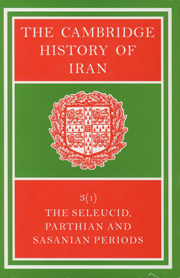Book contents
- Frontmatter
- Introduction
- PART 1 POLITICAL HISTORY
- PART 2 NUMISMATICS
- PART 3 IRANIAN HISTORICAL TRADITION
- PART 4 IRAN AND HER NEIGHBOURS
- 11 Iran and Mesopotamia
- 12 IRAN, ARMENIA AND GEORGIA
- 13 Iran and China
- 14 Cultural Relations between Parthia and Rome
- 15 Byzantium and the Sasanians
- 16 Iran and the Arabs before Islam
- 17 Irano-Turkish Relations in the Late Sasanian Period
- Bibliography
- Plate section
- Plate section
- Plate section
- Map 3. The western regions of the Sasanian empire">
- Map 11. The Silk Road from China to the Roman Orient
- References
12 - IRAN, ARMENIA AND GEORGIA
from PART 4 - IRAN AND HER NEIGHBOURS
Published online by Cambridge University Press: 28 March 2008
- Frontmatter
- Introduction
- PART 1 POLITICAL HISTORY
- PART 2 NUMISMATICS
- PART 3 IRANIAN HISTORICAL TRADITION
- PART 4 IRAN AND HER NEIGHBOURS
- 11 Iran and Mesopotamia
- 12 IRAN, ARMENIA AND GEORGIA
- 13 Iran and China
- 14 Cultural Relations between Parthia and Rome
- 15 Byzantium and the Sasanians
- 16 Iran and the Arabs before Islam
- 17 Irano-Turkish Relations in the Late Sasanian Period
- Bibliography
- Plate section
- Plate section
- Plate section
- Map 3. The western regions of the Sasanian empire">
- Map 11. The Silk Road from China to the Roman Orient
- References
Summary
POLITICAL CONTACTS
The geographical, historical and cultural links between Iran and the Caucasian area extend into remote antiquity. The Caucasus range has been from time immemorial the barrier separating the Eurasian steppe lands from more advanced civilizations centred on Mesopotamia and Anatolia. The Armenian plateau, with its mighty volcanic peaks, later imposed a formidable barrier to the westward drive of the Iranian people, once they were firmly established in their historical habitat. There is little doubt that some of the ancestors of the Iranians, like the Hittites and other Indo-European warrior aristocracies, entered Armenia from the north along the Caspian littoral, which was to be for centuries the classic invasion route for northern nomads attracted by the wealth and economic opportunities of the ancient Near East.
During the Early Bronze Age, extending through the 3rd millennium B.C., north-western Iran formed a single cultural zone with Armenia and southern Georgia, which all entered into the orbit of what is generally knows as the Kuro-Araxes culture. This in turn links up with the Khirbet-kerak pottery culture of Palestine and Syria. The connections between the Armenian and Iranian Middle and Late Bronze Ages are well known, while the Luristān bronzes are sometimes now attributed to Cimmerians who had entered Iran by way of the Caucasus (pl. 36(a)).
During recent decades, archaeologists have devoted increasing interest to the civilization of Urartu, the mighty rival of Assyria. The kingdom of Urartu flourished in a vast region centred on Lake Vān in Armenia, and incorporated at one time the advanced culture of the Mannians, around Lake Urmiya.
Keywords
- Type
- Chapter
- Information
- The Cambridge History of Iran , pp. 505 - 536Publisher: Cambridge University PressPrint publication year: 1983
References
- 9
- Cited by



